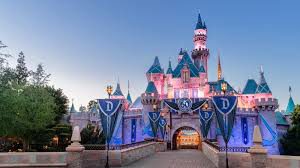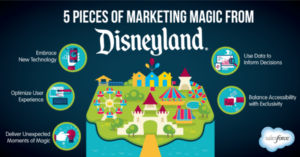Walt Disney once said of Disneyland, “What this country really needs is an amusement park where families can take their children to” (O’Leary, 2008). With the creation of Disneyland, and Florida’s Walt Disney World Resort, Walt Disney lived up to this ideal. Six Disney theme parks hold the top six spots for U.S. theme park attendance and its top two parks (The Magic Kingdom in Orlando, Florida and Disneyland in Anaheim, California) attracted over 20 million and 17 million visitors last year (respectively) (Barnes, 2017).
It is no secret that Disney Theme Parks, both domestic and international, have cornered the market on magic, and keep visitors coming back again and again. Salesforce has even identified the main ingredients to Disney’s theme park success which most notably includes the “balance between accessibility and exclusivity” (Wesson, 2014). Meaning, aside from the baseline of experiences that come with a basic theme park ticket, Disney offers more “magical experiences” at a higher cost. Think of it as the more you pay, the more pixie dust comes your way (see Salesforce’s take below).
Where is the bad news in all of this? Attendance at all Disney theme parks was down at fourteen Disney theme parks in 2016 (Barnes, 2017). Disneyland Paris also saw a dramatic attendance dip of 14 percent (Barnes, 2017). According to the Orlando Sentinel, a week at Disney costs a family of four $5,000 on average and a ticket to the Magic Kingdom now costs $1o5 a day (a figure that has doubled within the past decade) (Barnes, 2017). Moreover, The Washington Post estimates that the average Disney-bound family makes over $93,000 a year (a figure way above most middle-class family incomes) (Harwell, 2015).
Naturally, theme park attendance fluctuates from year to year and is based on a number of factors. With Disney’s latest acquisitions of Marvel and Lucasfilm, it is unlikely that Disney will not see more visitors in the near future. However, with Disney park tickets at an all-time high, and with wealthy families experiencing most of the magic, it will be interesting to see if Disney is changing its overall marketing strategy when it comes to its theme parks. Does Disney really want to create an amusement enterprise where all families can “take their children to”? Or, is Disney eyeing families who can stay longer and spend more? One thing is for sure, Disney magic comes with a hefty price tag, and it will be interesting to see if Disney adapts its marketing strategies as ticket prices soar. Will Disney halt the rise of its theme park tickets to keep up with attendance? Is attendance no longer a factor in Disney’s model of success and profit? Or will attendance transcend ticket prices as Disney introduces new key players with Marvel and Lucasfilm? It certainly makes for one “wild ride.”
References
Barnes, B. (2017, May 31). Attendance drops at Disney parks worldwide as prices rise. Retrieved on June 25, 2017 from https://www.nytimes.com/2017/06/01/business/media/disney-theme-parks-universal-attendance.html
Harwell, D. (2015, June 12). How theme parks like Disney World left the middle class behind. Retrieved on June 25, 2017 from https://www.washingtonpost.com/news/business/wp/2015/06/12/how-theme-parks-like-disney-world-left-the-middle-class-behind/?utm_term=.3e680dd68fdd
Maxwell, S. (2015, Nov 07). OPINION: Yes, disney prices out many families. why? because it can. TCA Regional News Retrieved from http://libproxy.usc.edu/login?url=http://search.proquest.com.libproxy1.usc.edu/docview/1731600561?accountid=14749
O’Leary, C. (2008). Walt Disney’s Worlds. Retrieved June 25, 2017, from http://www.chrisoleary.com/projects/TheParadoxOfPain/Book/Profile_WaltDisney.html
Wesson, M. (2014, Sept 02). 5 pieces of marketing magic from Disneyland. Retrieved on June 25 2017 from https://www.marketingcloud.com/blog/5-pieces-of-marketing-magic-from-disneyland/



4 Responses to Disney and the Monopoly of Magic: Will Theme Park Prices Affect Image?